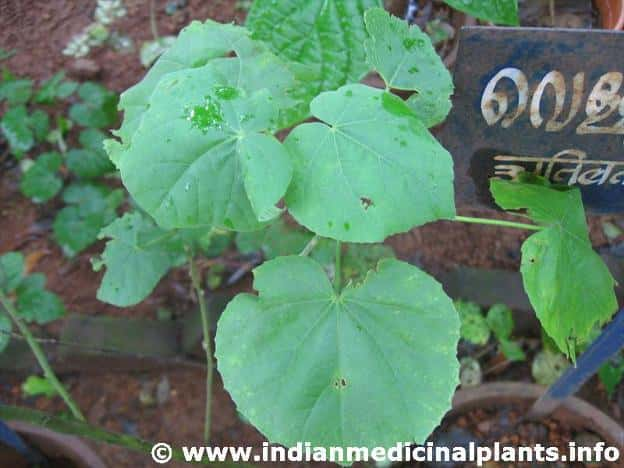
Botanical Name : Abution indicum (Linn.)
Family : MALVACEAE
Introduction : It mainly used for nerve disorders like paralysis and vatha prominent disorders. it is also used as the adulterant of bala.The plant contains mucilage, tannins,asparagines, gallic acid and sesquiterpenes. Presence of alkaloids,leucoanthocyanins, flavonoids, sterols, triterpenoids, saponins and cardiac glycosides is also reported. Asparagine is diuretic. Gallic acid is analgesic. Mucilages act by reflex, loosen cough as well as bronchial tension.
Essential oil—antibacterial, antifungal. The drug exhibits immunological activity.
Names in different Indian languages :
English : Country Mallow, Indian mallow, Flowering Maples, Chinese Bell-flowers
Hindi : Jampi, Kangi
Malayalam : Oorpam,kaluram,kattoram,vellurum,kattoram
Sanskrit : Ati Bala
Tamil : Perum tutti, paniyarattutti
Telugu : Tutturu Benda, Duvvenakaya
Synonyms :
Atibalaa, Rishyaproktaa.,, Kañkatikã, Balikã, Rishyagandha, Bhuribalã
Varieties & adulterants – (CV – controversy, AD – adulterants) :
Controversial Studies— Another species A. theophrastii Mdic. (A. avicennae Gaertn). is also used by some as Ati-balã because of their similarity in appearance.
Varieties & adulterants
1. Balätraya
2. BaIã chatuska ( Baladvaya and Mahabala )
3. A. theophrasti Mdic.
4. A. avicennae Gaertn.
5. Abutilon ranadei
6. Abutilon ranadei
Morphology :
It is a perennial softly tomentose shrub, upto 3 m. high.
Stem—round, frequently tinged with purple.
Leaves—ovate to orbicular-cordate, 2-2.5 cm. long.
Flowers— Solitary on jointed peduncles, orange-yellow or yellow.
Seeds: 3-5, reniform, tubercled or minutely stellate-hairy, black or dark brown. (Flowers and fruits almost throughout the year)
Distribution & Habitat :
Found as a weed in all over India, the sub-Himalayan tract and hills upto 1,400 m. and in hotter parts of Srilanka.
Chemical constituents :
mucilage, tannins, asparagines, gallic acid and sesquiterpenes. leucoanthocyanins, flavonoids, sterols, triterpenoids, saponins, cardiac glycosides. Hescoses, beta-sitosterol, vanillic, p-coumaric, amino acids; alantolactone, isoalantolactone
Properties :
Rasa : Madhura
Guna : Laghu, Snigdha
Virya : Sita
Vipäka : Madhura
Karma : Vãta-Pitta hara, Balya, Bramhana, Vrsya
Indication :
Vãta vyãdhi, Prameha, Raktapitta, Kasaghna
Dried, whole plant— febrifuge, anthelmintic, demulcent, diuretic, anti-inflammatory (in urinary and uterine discharges, piles, lumbago).
Juice of the plant— emollient.
Seeds—demulcent (used in cough, chronic cystitis), laxative.
Leaves—cooked and eaten for bleeding piles.
Flowers— antibacterial, anti-inflammatory.
Bark—astringent, diuretic.
Root— nervine tonic, given in paralysis; also prescribed in strangury.
Also useful in gout, polyuria and haemorrhagic
Part used :
Root
Dosage :
Root powder 2-3 g.
Decoction 50-100 ml
External uses :
Paste is analgesic and alleviates oedema. It is locally applied over inflammation and eye disorders.
Internal uses :
Central nervous-system : Being neural tonic and vata-shamak, it is useful in vata disorders like paralysis, facial palsy
Digestive system : Emollient, astringent..
Circulatory system : Cardiac tonic and alleviates hemorrhagic disorders & bronchiectsis. Reproductive system Aphrodisiac and useful in spermatorrhoea
Urinary system: Diuretic, so useful in dysuria.
Temperature : Useful in fever being a febrifuge
Satmikaran : Tuberculosis and undernourishment.
Important Yogas or Formulations :
Atibala rasayana
Therapeutic Uses :
(1) Slipada— Balã and Atibalã are taken with milk early in the morning.
(2) Mutrakrichra-Decoction of Atibalã will be useful.
(3) Rakta Pradara— Root powder of Atibala is given with sugar & honey.
(4) Root powder + kokilaksha seeds useful in gout





